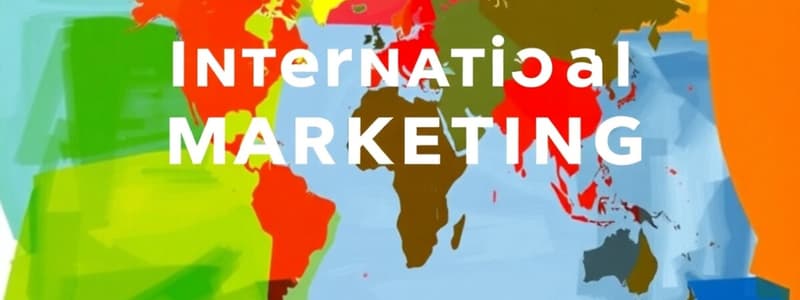Podcast
Questions and Answers
What is a proactive internal rationale for brands to enter international markets?
What is a proactive internal rationale for brands to enter international markets?
- Declining domestic market (correct)
- Diversifying risk
- Unsolicited Order
- Government assistance
Which international marketing strategy involves tailoring products to each local market?
Which international marketing strategy involves tailoring products to each local market?
- Standardization strategy
- Global strategy
- Multi-domestic strategy (correct)
- Transnational strategy
Which of the following is considered a cultural risk in international marketing?
Which of the following is considered a cultural risk in international marketing?
- Government corruption
- Ethical practices (correct)
- Weak partner relationships
- Foreign tax implications
What is one of the quantitative methods for assessing political risk?
What is one of the quantitative methods for assessing political risk?
What is a common motivation for government intervention in international trade?
What is a common motivation for government intervention in international trade?
What is a primary characteristic of a long export channel?
What is a primary characteristic of a long export channel?
Which entry strategy involves establishing a completely new operation in the target country?
Which entry strategy involves establishing a completely new operation in the target country?
What is an essential factor for companies when deciding between export-based and manufacturing-based entry strategies?
What is an essential factor for companies when deciding between export-based and manufacturing-based entry strategies?
What does the adaptation strategy in international product strategies primarily address?
What does the adaptation strategy in international product strategies primarily address?
Which constraint in international promotion can significantly impact the effectiveness of marketing?
Which constraint in international promotion can significantly impact the effectiveness of marketing?
What is the primary goal of changing packaging and labeling for international markets?
What is the primary goal of changing packaging and labeling for international markets?
Which message strategy allows for a standardized message with minimal local adaptation?
Which message strategy allows for a standardized message with minimal local adaptation?
What typically drives the decision between extension and adaptation product strategies?
What typically drives the decision between extension and adaptation product strategies?
What is a negative consequence of higher standards of goods in protectionist tactics?
What is a negative consequence of higher standards of goods in protectionist tactics?
Which of the following best describes the role of the World Trade Organization?
Which of the following best describes the role of the World Trade Organization?
In which scenario would a country likely have a high Gross National Income (GNI) per capita?
In which scenario would a country likely have a high Gross National Income (GNI) per capita?
What is one major limitation of Porter's 5 Forces Analysis?
What is one major limitation of Porter's 5 Forces Analysis?
Which of the following components is NOT part of PESTLE analysis?
Which of the following components is NOT part of PESTLE analysis?
What strategy best characterizes a simultaneous market entry approach?
What strategy best characterizes a simultaneous market entry approach?
Which dimension of Hofstede's cultural dimensions model would likely affect market behavior most significantly in a highly individualistic culture?
Which dimension of Hofstede's cultural dimensions model would likely affect market behavior most significantly in a highly individualistic culture?
Which type of international trade agreement involves two countries working closely together?
Which type of international trade agreement involves two countries working closely together?
Flashcards are hidden until you start studying
Study Notes
Rationales for International Marketing
- Proactive Internal: Companies may seek international markets due to a small or declining domestic market.
- Proactive External: Businesses may expand internationally due to opportunities in foreign markets or government assistance.
- Reactive Internal: Diversifying risk and reducing seasonality are internal reactive reasons for international expansion.
- Reactive External: Unsolicited orders from foreign markets can initiate international marketing endeavors.
Generic International Strategies
- Global: A standardized strategy with uniform marketing efforts across all markets.
- Transnational: Balances global integration with local responsiveness.
- Multi-domestic: Customization of products and marketing strategies to suit specific local markets.
Risks in International Marketing
- Cultural risks: Differences in ethical practices and consumer behavior can pose challenges.
- Commercial risks: Unreliable partners and timing of market entry can lead to setbacks.
- Financial Risks: Currency fluctuations, foreign taxes, and economic instability can create financial hardship.
- Political Risks: Civil unrest, corruption, and government regulations pose political challenges for international marketers.
The Wheel of International Marketing
- A visual representation of the international marketing process.
- Outlines stages of international marketing, starting with market research and ending with implementation and control.
Predictors/Indicators of Political Instability
- Frequency of changes in the regime: Frequent changes in leadership suggest potential political instability.
- Religious division: Religious tensions and conflicts can contribute to political instability.
Factors Evaluated When Assessing Political Risk
- Political: Stability of the government, democratic processes, and presence of a capitalist system are assessed.
- Product: The importance of the product to the country's economy is evaluated.
- Diplomatic: The international relations of the country are considered.
- Company: The company's reputation and experience in dealing with international risks are taken into account.
Methods for Assessing Political Risk
- The Grand Tour: Executives visit the country to make a first-hand assessment.
- The Old Hand: Experts on the country provide advice on political risks.
- Delphi Technique: A group of specialists provides anonymous opinions on potential risks.
- Quantitative Methods: Mathematical models are used to analyze data and predict the likelihood of events.
How Brands Can Manage Political Risk
- Building relationships with local communities: Engaging in social responsibility activities can foster positive relationships with communities and reduce political risk.
Motivations for and Negative Outcomes of Government Intervention (Protectionism)
- Motivations: Protecting national economic interests, supporting domestic industries, and addressing potential economic challenges.
- Negative Outcomes: Higher prices for consumers, reduced competition, and disruptions to supply chains.
Technological Considerations in International Markets
- Cybersecurity: Data protection and online security are crucial for international operations.
- Technology Infrastructure: The level of technological development in the target market should be assessed.
How Economies Develop (Rostow's Model)
- Five stages of economic development: Traditional Society, Preconditions for Take-Off, Take-Off, Drive to Maturity, and Age of High Mass Consumption.
- The model illustrates the progression of economies from traditional to advanced stages.
Other Metrics Useful in Measuring a Country's Economy
- GDP: Gross Domestic Product reflects the total value of goods and services produced.
- Debt: High levels of national debt can impact economic stability and growth.
- Unemployment and Inflation: These indicators measure the health of the economy's labor market and price stability.
Examples of Protectionist Tactics/Behaviors
- Tariffs: Taxes imposed on imported goods to increase their price and protect domestic producers.
- Higher Standards of Goods: Setting stricter standards for imported products to create barriers for foreign competitors.
Three Forms of International Trade Agreements
- Multinational: Agreements, like the World Trade Organization, regulate international trade and aim to reduce barriers.
- Regional Trade Groups: Groups of nations, such as the European Union, collaborate to promote trade and economic integration.
- Bilateral Trade Agreements: Trade agreements between two countries, focusing on specific goods and services.
Environmental Considerations in International Markets
- Sustainability: Environmental impact and sustainability practices are increasingly important considerations for businesses.
- Weather: Climate conditions can affect products, supply chains, and marketing strategies.
- Environment Policy: Local environmental regulations and policies should be taken into account.
Hofstede's Cultural Dimensions Model
- Power Distance: The extent to which individuals accept inequality.
- Individualism vs. Collectivism: The degree of emphasis on individual or collective goals.
- Masculinity vs. Femininity: The importance of assertiveness and achievement versus nurturing and quality of life.
- Uncertainty Avoidance: Tolerance for ambiguity and risk.
- Long-Term Orientation: Emphasis on long-term goals and traditions versus short-term gratification.
Implications of Intranational Hetero/Homogeneity
- Heterogeneity: Significant religious, linguistic, or cultural differences within a country, like India.
- Homogeneity: Limited cultural variation within a country, like Japan, where a large majority speaks Japanese.
How Countries Develop National Competitive Advantage (NCA)
- NCA arises from industries thriving in specific locations due to factors like skilled labor, resources, and infrastructure.
- China's manufacturing sector thrives due to a large and skilled workforce.
How and Why to Conduct Porter's 5 Forces Analysis
- A framework for analyzing the competitive landscape of an industry.
- Helps identify key competitive forces, including:
- Threat of New Entrants
- Bargaining Power of Suppliers
- Bargaining Power of Buyers
- Threat of Substitute Products
- Rivalry Among Existing Competitors
How and Why to Conduct PESTLE Analysis
- A method for analyzing the external environment of an organization.
- Helps identify opportunities and threats related to:
- Political
- Economic
- Social
- Technological
- Legal
- Environmental factors
How and Why to Conduct SWOT Analysis
- A tool for evaluating an organization's internal strengths and weaknesses, along with external opportunities and threats.
- Provides insights for developing strategic plans.
Five-Stage Screening Process for International Market Selection
- A sequential process for evaluating and selecting international markets.
- Stages:
- Domestic Considerations: Evaluate internal resources and capabilities.
- Macro-Environmental Factors: Assess political, economic, social, technological, legal, and environmental factors.
- Competitive Environment: Analyze competitive landscape and industry dynamics.
- Response to Marketing Activities: Assess potential market response to marketing efforts.
- Firm's Internal Trade-offs and Objectives: Consider company objectives and resource allocation.
Incremental vs Simultaneous Entry Strategies
- Incremental Entry: Entering one foreign market at a time.
- Simultaneous Entry: Entering multiple foreign markets concurrently.
Export-Based Entry Approaches
- Direct Export: Selling directly to customers in the target market.
- Indirect Export: Selling through intermediaries in the home country who export goods.
- Direct Sales Forces: Establishing a sales office in the target market.
- Licensing: Granting a foreign company the right to produce and sell products in its market.
- Franchising: Granting a foreign company the right to use its brand and business model.
Manufacturing-Based Entry Approaches
- Joint Venture: Collaboration with a foreign company to establish joint operations.
- Consortia: A large group of companies coming together for a specific project.
- Acquisition: Purchasing a foreign company to gain access to markets and resources.
- Greenfield Investment: Establishing a new subsidiary in a foreign country.
Dunning's Eclectic Paradigm
- A framework for understanding international business entry strategies.
- Three key components:
- Ownership Advantages: Internal strengths and capabilities of the company.
- Location Advantages: Characteristics of the target market, such as infrastructure, labor costs, and regulatory environment.
- Internalization Advantages: Benefits of operating directly in the target market, such as control and coordination.
Export-Based Entry Channel Maps
- Long Channel: Multiple intermediaries involved in the distribution process.
- Short Channel: Fewer intermediaries, allowing for more direct control and faster communication.
Determinants of Export-Based Strategies
- Cost: Economic feasibility of exporting versus manufacturing.
- Control: Level of control over the distribution process.
- Nature of the Market: The size, growth potential, and competitive intensity of the target market.
- Nature of the Product: The complexity and value of the product, and how it is likely to be transported.
Generic Product Strategies
- Product Extension: Using the same product as in the home market.
- Product Adaptation: Making changes to the product to better suit the local market.
- Product Invention: Developing a new product specifically for the local market.
Forces that Drive Extension vs. Adaptation Strategy
- Product Extension: Economies of scale and standardized products.
- Product Adaptation: Diverse customer preferences and regulatory requirements.
Country-of-Origin Effects
- Perceptions and stereotypes associated with a product's country of origin.
- Austrian wine may benefit from positive country-of-origin effects.
- A company could disguise the origin of its product, such as branding a product as "Rebel" to avoid negative country-of-origin associations.
Changes to Packaging and Labelling for International Markets
- Adapt packaging design for local requirements and preferences.
- Translate labels and product information for the target market.
- Consider cultural sensitivities and preferences when designing packaging.
Constraints in International Promotion
- Language Barriers: Translating marketing messages to different languages.
- Government Controls: Regulations and restrictions on advertising and promotional activities.
- Media Availability: Accessibility and reach of various media channels.
Promotional Mix (Advertising Only)
- Advertising: Paid communication through various media to promote a product or service.
Message Strategies
- Laissez Faire: Local teams have high autonomy in developing marketing messages.
- Prototype: A standardized messaging prototype can be adapted by local teams while maintaining core brand elements.
- Export: A uniform message is used across all international markets with minimal adaptation.
Considerations in International Media Selection
- Media Availability: The availability and reach of various media channels.
- Media Consumption Habits: The media consumption patterns of the target audience.
- Media Costs: The cost of advertising in different media channels.
Studying That Suits You
Use AI to generate personalized quizzes and flashcards to suit your learning preferences.




